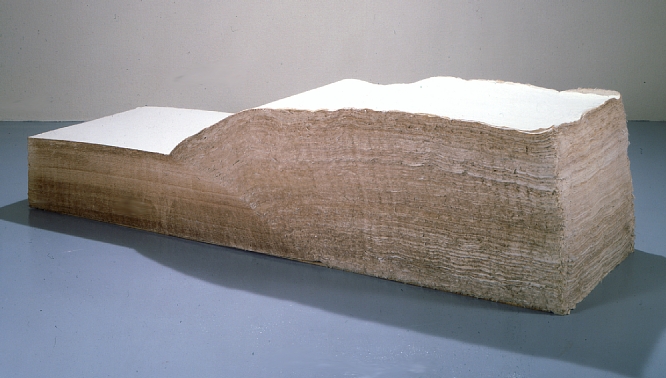| The
Spontaneous Art of Kazuo Kadonaga THE SALT LAKE TRIBUNE BY BRANDON GRIGGS/ART REVIEW Sunday,September 23, 2001 |
At at first glance, Kazuo Kadonaga's artworks are baffling: An enormous cedar log, carved with parallel lines. A row of 15-foot-long bamboo poles, leaning against a wall. A beehive-shaped mound of glass.
Study them closely, however, and the unique vision behind Kadonaga 's curious creations begins to emerge. At a time when many trends in, contemporary art are exhausted, Kadonaga is that rare artist whose work is strikingly original - if impractical for home display by the average collector.
His solo exhibit, subtitled "wood Paper Bamboo Glass,h opened Friday at the newly remodeled Salt Lake Art Center, where it will remain through Nov.25.Spanning 20 years of work by the Japanese-born International artist, it marks the first show in the center's main gallery since its staircase entryway was reconfigured to create more exhibition space for the 2002 Winter Olympics.
The roomier gallery feels appropriate for Kadonaga's large-scale sculptural pieces, some of which need the perspective of distance to be appreciated. To truly understand Kadonaga's work, however, requires some background into how he makes it.
gKazuo has always been more interested in the [artistic] process than in any artifact itself," says Salt Lake Art Center director Ric Collier, who curated the show. "While the resulting works are beautiful and mysterious, they are but by-products of his consuming passion to pursue the unknown through . . . the manipulation of natural materials. "
A Longtime fan of Kadonaga's work, Collier first encountered the artist 16 years ago in Los Angeles. Collier curated a solo Kadonaga show in Corpus
Christi Tex., in 1988 and has been trying to bring the artist to Utah since becoming director of the Salt Lake Art Center five years ago.
 |
| Translucent green glass forms a beehive shape in gGlass No 4 Mh |
When Kadonaga began making art in earnest in 1971,
he was drawn to wood-not because he loved its feel but because his family
ran a lumber mill in northern Japan and wood was plentiful and cheap. In
subsequent years, he experimented with paper, silk and glass. With a simplicity
characteristic of his native country, Kadonaga tinkers with these raw materials
to see how they respond when physically altered or exposed to changes in
their environment.
For example,
one of the exhibit's pieces is a bark less cedar log about 15 feet long. Kadonaga
used a table saw to slice the log length wise into hundreds of paper-thin
sheets, then reassembled it. As the wood responds to changes in temperature and
humidity, the paper-thin sheets buckle or curl - changing the logfs appearance.
In this way, Kadonaga lets his materials dictate their ultimate shape. The end result
is random, unpredictable and fluid. For one installation years ago. Kadonaga
dried a number of cedar and bamboo pieces until they were on the verge of cracking,
then placed them in a gallery. Visitors were asked to sit on a nearby chair; if
they kept quiet they could hear the wood cracking, revealing the two materials'
distinct aural as well as visual characteristics.
Equally fascinating are Kadonaga'
s mounds of translucent green glass, each lit from above by a spotlight that
makes them appear to glow from within. After years of experimentation, Kadonaga
became intrigued with the viscous quality of molten glass. He developed a system
to melt glass in a kiln at 2,600 degrees, then drip it continuously onto a
cooling furnace below, creating layered, billowing shapes that take more than
three months to harden.
 |
| Handmade paper is layered gPaper No.1BF,h a 1983 work by Kazuo Kadonaga |
The results conjure images of space-alien larva or soft-serve ice cream.
They are a far cry from the sculpted glass of Dale Chihuly-whose colorful
creations will inhabit the gallery during the Olympics.
Speaking through
an interpreter, Kadonaga says he enjoys the spontaneity of his work. He doesn't
imagine ahead of time how his pieces will evolve, nor does have any
expectations about how they win look when finished. He likes to keep his
artistic process as simple as possible.
| ¡ At Salt Lake Art Center "Kazuo Kadonaga: Wood Paper Bamboo Glass" will be exhibited through Nov. 25 at the Salt Lake Art Center, 20 S. West Temple in Salt lake City. The center is open every day but Monday; admission, as always, is free. |
In a catalogue that accompanies the exhibition, critic
Josine lanco-Starrels calls Kadonaga 's works gsimple, stark and without
artifice, yet uncommonly impressive.h lanco-Starrels said she had never
before seen wood or glass "presented simply as the elements they were,
the heart of their matter. Prior to this, they had appeared as materials
acted on by the artist. Wood had always been roughly hewn, smoothly sanded,
skillfully carved. This was different. The longer I looked at the
elements before me, the clearer the artist's intent became; the essence
of the material superseded the makerfs will."
Whether or
not you enjoy Kadonaga's art - and his deceptively simple works may leave some
observers scratching their heads - you could visit every art gallery in Utah
and not see anything like it. And that's a compliment.